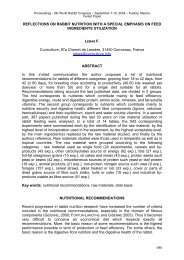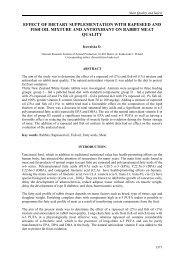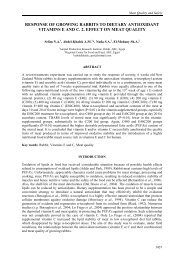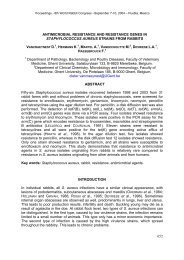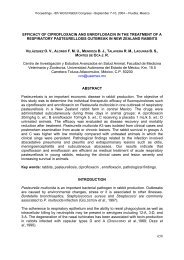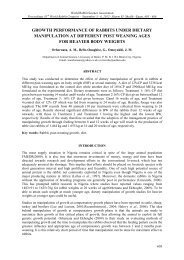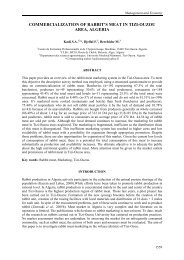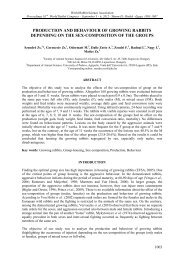economic sustainability of rabbit farming innovations - World Rabbit ...
economic sustainability of rabbit farming innovations - World Rabbit ...
economic sustainability of rabbit farming innovations - World Rabbit ...
Create successful ePaper yourself
Turn your PDF publications into a flip-book with our unique Google optimized e-Paper software.
Management and Economy<br />
ECONOMIC SUSTAINABILITY OF RABBIT FARMING<br />
INNOVATIONS<br />
Bertazzoli A., Rivaroli S.*<br />
Department <strong>of</strong> Agricultural Economic and Engineering, Alma Mater Studiorum – University <strong>of</strong> Bologna,<br />
Viale Giuseppe Fanin 50, 40127 Bologna, Italy<br />
*Corresponding author: sergio.rivaroli@unibo.it<br />
ABSTRACT<br />
Although multiple definitions have been proposed for the concept <strong>of</strong> animal welfare, the interpretation<br />
<strong>of</strong>fered by Webster is <strong>of</strong> particular interest for the purposes <strong>of</strong> this study. The author, despite basing<br />
himself on the definition proposed by the UK Farm Animal Welfare Council (FAWC), lists five<br />
determining factors <strong>of</strong> animal welfare, including the prevention <strong>of</strong> the animal’s physical and mental<br />
exhaustion induced by intensive productive and reproductive activities. With specific reference to<br />
<strong>rabbit</strong> <strong>farming</strong>, it is necessary to underline that research predominantly focuses on evaluating the<br />
impact which technical <strong>innovations</strong> - in terms <strong>of</strong> animal population density, cage sizing and the<br />
improvement <strong>of</strong> environmental conditions - have on animal welfare, and is underpinned by a<br />
predominantly anthropocentric viewpoint. A limited number <strong>of</strong> studies focus on evaluating the impact<br />
<strong>of</strong> organisational <strong>innovations</strong> which are aimed at protecting and respecting the physiology <strong>of</strong> the<br />
animals. The purpose <strong>of</strong> this study is to evaluate the <strong>economic</strong> <strong>sustainability</strong> <strong>of</strong> adopting a less<br />
intensive insemination rhythm with a view to safeguarding the welfare <strong>of</strong> breeding does. The findings<br />
<strong>of</strong> this study reveal that the innovation in question is able to guarantee positive financial returns for the<br />
business, as well as a substantial reduction in the risks associated with the production activity.<br />
Key words: Cost-volume-pr<strong>of</strong>ile analysis (CVP), Animal welfare, Post-weaning rhythm.<br />
INTRODUCTION<br />
Animal welfare is a topic <strong>of</strong> much public and scientific debate, such that it has led to important<br />
changes in European legislation aimed at meeting the growing demand for high-quality, safe food and<br />
ethical production. The extensive European legislation in this area (Eurogroup, 1995) is essentially<br />
based on the “protocol <strong>of</strong> protection and welfare <strong>of</strong> animals” (Horgan et al., 2006). In particular,<br />
reared animals must be treated as “sentient and conscious beings”, can experience emotions and are<br />
therefore not comparable to other agricultural products. Nevertheless, different definitions have been<br />
proposed for the concept <strong>of</strong> animal welfare, reflecting the actual characteristics <strong>of</strong> the applicable<br />
regulatory environment and the measures currently used to verify animal welfare status. Consequently,<br />
literature has paid particular attention to the interpretation <strong>of</strong>fered by the UK Farm Animal Welfare<br />
Council (FAWC) in 1993 (“the Five Freedoms”). This definition, despite being widely accepted, is<br />
nevertheless criticised for its largely anthropocentric vision (Webster, 2001; Korte et al., 2007). In<br />
particular, Webster (2001) emphasises that prevention and the protection <strong>of</strong> animals from potential<br />
states <strong>of</strong> suffering, rather than the utopian ideal in which all suffering is eliminated, is the prerequisite<br />
to ensuring animal welfare. In subsequently proposing “the Five Freedoms”, the author incorporates<br />
the prevention <strong>of</strong> the animal’s physical and mental exhaustion induced by intensive productive and<br />
reproductive activities. In attempting to propose how the FAWC principles should be converted into<br />
action, Webster (2001) defines resources and management as areas which the livestock farmer can<br />
control in order to ensure the welfare <strong>of</strong> his animals. Although the availability <strong>of</strong> adequate <strong>farming</strong><br />
resources (feed, sanitation, quantity and quality <strong>of</strong> space) are certainly elements which correlate with<br />
most <strong>of</strong> the determining factors mentioned by the FAWC, <strong>of</strong> particular interest for this study is<br />
Webster’s idea that the prevention <strong>of</strong> mental and physical exhaustion induced by intensive<br />
reproductive activity may be considered a managerial aspect which the breeder can use to promote<br />
1509
9 th <strong>World</strong> <strong>Rabbit</strong> Congress – June 10-13, 2008 – Verona – Italy<br />
animal welfare. With specific reference to <strong>rabbit</strong> <strong>farming</strong>, it is necessary to underline that research<br />
primarily focuses on evaluating the impact which individual <strong>innovations</strong> have on animal welfare. In<br />
the majority <strong>of</strong> cases, these are technical <strong>innovations</strong> related to cage sizing and the improvement <strong>of</strong><br />
husbandry conditions by enhancing the environment in which the animals are reared (Morisse et al.,<br />
1996; Morisse, 1999; Xiccato et al., 1999). A limited number <strong>of</strong> studies focus on evaluating the impact<br />
on animal well-being and business performance <strong>of</strong> organisational solutions for protecting the<br />
physiology <strong>of</strong> the animal, by preventing its physical and metabolic exhaustion as described by<br />
Webster (2001). Based on the above considerations, this study aims to evaluate the <strong>economic</strong><br />
<strong>sustainability</strong> <strong>of</strong> adopting a less intensive insemination rhythm with a view to promoting animal<br />
welfare, as proposed by Castellini et al. (2006).<br />
MATERIALS AND METHODS<br />
The analysis is based on technical and <strong>economic</strong> information collated from three <strong>rabbit</strong> farms by<br />
means <strong>of</strong> in-depth interviews. The interviews were conducted with the help <strong>of</strong> a questionnaire to<br />
systematically detect general information about the business (location, cultivated area, management<br />
format and work unit), the <strong>rabbit</strong>ry (average population, reproductive parameters <strong>of</strong> the maternity and<br />
growth sections), housing arrangements (cage type and dimensions, types <strong>of</strong> environmental control,<br />
waste management), management costs and capital used for running the operation. Two <strong>of</strong> the three<br />
livestock farms in the survey are located in the province <strong>of</strong> Padua, while the other is located in the<br />
province <strong>of</strong> Perugia. All three farms are directly operated by the owner and their family members,<br />
assisted by temporary workers. The average total farm area is 33 hectares, while the average number<br />
<strong>of</strong> does is 1,167 (Table 1).<br />
Table 1: Technical and <strong>economic</strong> pr<strong>of</strong>ile <strong>of</strong> farms<br />
Mean<br />
St.Dev.<br />
Total area (hectares) 33 27.2<br />
Labour (ULU) a 3 2.6<br />
Fixed assets (Euro) (b) 486,870 0.5<br />
Average <strong>rabbit</strong> population<br />
- Bucks (n.) 58 0.3<br />
- Does (n.) 1,167 0.5<br />
- Nulliparous females (n.) 250 0.9<br />
- Fattening animals (n.) 8,200 0.7<br />
Rhythms and reproductive life <strong>of</strong> breeding animals<br />
- Duration <strong>of</strong> reproductive life (years) 2 0.1<br />
- Average kindlings per year (n.) 7 0.1<br />
- Kindling-to-mating interval (days) 11 0.0<br />
- Kindling interval (days) 42 0.0<br />
- Equalisation (kits/litter) 8 0.0<br />
- Replacement rate (%) 83 0.4<br />
- Fattening mortality (%) 5 0.4<br />
- Fryers for slaughter (n.) 60,000 0.7<br />
- Weight <strong>of</strong> fryers (g) 2,630 0.0<br />
- Age <strong>of</strong> fryers sold (days) 80 0.1<br />
Note: (a) Working Unit = 1,800 hours; (b) Animals capital, structure and equipment.<br />
The parameters relating to the performance <strong>of</strong> does and fryers following the adoption <strong>of</strong> a less intense<br />
reproductive rhythm refer to the findings <strong>of</strong> research conducted by Castellini et al. (2006). In<br />
particular, it is considered that by extending the kindling-to-mating interval from 11 days to 32 days<br />
the following results may be obtained: reduction <strong>of</strong> fattening mortality from 5% to 2%; average sale<br />
weight <strong>of</strong> kit <strong>of</strong> 280 g; production <strong>of</strong> an average litter <strong>of</strong> 9 kits by breeding females. In order to<br />
evaluate the technical and <strong>economic</strong> <strong>sustainability</strong> <strong>of</strong> the innovation, quantities and costs <strong>of</strong> factors <strong>of</strong><br />
production are referred to the year 2006, while the analysis <strong>of</strong> fryer sales prices for the period 2002-<br />
2007 refers to information contained in price lists issued by the Verona Commodities Exchange.<br />
The methodological approach used in this study adheres closely to the research approach <strong>of</strong> the case<br />
study analysis. The findings, despite not being statistically representative, provide the reader with<br />
1510
Management and Economy<br />
points for reflecting on the potential impact <strong>of</strong> the given innovation on the <strong>economic</strong> <strong>sustainability</strong> <strong>of</strong><br />
the <strong>rabbit</strong> farm. In fact the case studies analysis, which is widely used in academic fields such as<br />
sociology and psychology, has recently also generated growing interest in <strong>economic</strong> fields (Ghauri et<br />
al., 2002; Yin, 2003). For example, Stake (2000) asserts that this analytical approach is capable <strong>of</strong><br />
“studying the detail”, that is to say examining a specific subject in-depth. Yin (2003) asserts that,<br />
when conducting a case studies analysis, it is necessary to satisfy four conditions: construct validity,<br />
using multiple sources <strong>of</strong> evidence to collate detailed information on the subject <strong>of</strong> the analysis;<br />
internal validity, using shareable analysis criteria; external validity, ensuring the repeatability <strong>of</strong> the<br />
approach for the analysis <strong>of</strong> other case studies; reliability, in other words <strong>of</strong>fering the possibility <strong>of</strong><br />
defining a new analytical protocol to collect new data. In the case at hand, the construct validity <strong>of</strong> the<br />
analysis is guaranteed by the collation <strong>of</strong> detailed information from three <strong>rabbit</strong> farms. Internal validity<br />
is guaranteed by the use <strong>of</strong> accepted and established analytical techniques, such as production cost<br />
analysis (Moisello, 2000), cost-volume-pr<strong>of</strong>ile analysis (CVP) (Horngren et al., 2005) and the analysis<br />
<strong>of</strong> isopr<strong>of</strong>it curves. Furthermore, the analysis protocol can be repeated in other livestock farms,<br />
thereby ensuring the repeatability and reliability <strong>of</strong> this analytical approach.<br />
The analysis <strong>of</strong> the production costs <strong>of</strong> each livestock farm provided a starting point for both the CVP<br />
analysis and the definition <strong>of</strong> “pre” and “post” innovation isopr<strong>of</strong>it levels. Despite the inherent<br />
limitations in the CVP analysis hypothesis (Ray and Eric 2004), the determination <strong>of</strong> the break-even<br />
point, the margin <strong>of</strong> safety, the unit pr<strong>of</strong>it and the equilibrium price both before the innovation (exante)<br />
and after the innovation (ex-post), made it possible to evaluate the impact <strong>of</strong> adopting less<br />
intensive insemination rhythms on the technical efficiency <strong>of</strong> the business. By contrast, the joint<br />
analysis <strong>of</strong> the producer’s sales price trends and the ex-ante and ex-post isopr<strong>of</strong>it curves made it<br />
possible to verify the <strong>economic</strong> <strong>sustainability</strong> <strong>of</strong> the innovation.<br />
RESULTS AND DISCUSSION<br />
Consistently with other studies on the production cost <strong>of</strong> <strong>rabbit</strong> meat (Biagini et al., 2000), <strong>of</strong> a total <strong>of</strong><br />
almost 1.7 euros/kilo sold, the most substantial components are feed (56%) and labour (20%). Less<br />
important are medicinal expenses, vets bills and fertilisation costs, which account for approximately<br />
8% <strong>of</strong> the overall cost. The CVP analysis highlights how the adoption <strong>of</strong> an extensive insemination<br />
rhythm reflects positively on the technical efficiency <strong>of</strong> the farm (Table 2).<br />
Table 2: Break-even point and <strong>economic</strong> aspects<br />
Variables Description Ex -ante Ex-post Var.%<br />
Qt Quantity <strong>of</strong> meat sold (.000 kg) 159 175 10.03<br />
BEP Break-Even Point (.000 kg) 123 104 -15.63<br />
Msic Margin <strong>of</strong> Safety (%) 22.6 40.6<br />
Mcu Unit contribution margin (Euro/kg) 0.59 0.70 18.53<br />
Peq Equilibrium price (Euro/kg) 1.67 1.51 -9.11<br />
The Break-Even Point (BEP), which represents the minimal production level below which the<br />
business incurs a loss, is over 123,000 kg in the ex-ante situation, whereas by adopting the<br />
organisational innovation in question this threshold could be cut to 104,000 kg (-16%).<br />
The margin <strong>of</strong> safety, which represents the maximum reduction in sales that a business can sustain<br />
before it makes a loss, is 41% in the ex-post situation, whereas in the ex-ante situation it is<br />
approximately 23%. A direct consequence <strong>of</strong> this improved performance is the reduction in the<br />
intrinsic risk <strong>of</strong> the activity. The innovation in question also appears to have a positive effect on the<br />
<strong>economic</strong> <strong>sustainability</strong> <strong>of</strong> the <strong>rabbit</strong> farm. Given the production levels achieved and presumed<br />
following the introduction <strong>of</strong> the innovation, the minimum sales price required to achieve a nonnegative<br />
return (equilibrium price) falls from 1.67 to 1.51 euros per kilogramme. The net <strong>economic</strong><br />
benefit per kilogramme <strong>of</strong> meat sold (unit contribution margin), which is generally reserved to cover<br />
the fixed costs incurred by the breeder regardless <strong>of</strong> the level <strong>of</strong> production obtained, improves<br />
markedly to 0.70 euros per kilogramme.<br />
1511
9 th <strong>World</strong> <strong>Rabbit</strong> Congress – June 10-13, 2008 – Verona – Italy<br />
The joint analysis <strong>of</strong> average sale prices on the Verona market (Figure 1) and <strong>of</strong> isopr<strong>of</strong>it curves<br />
(Figure 2) provides us with indications about the <strong>economic</strong> <strong>sustainability</strong> <strong>of</strong> the production activity<br />
both before and after the adoption <strong>of</strong> a less intensive insemination cycle. In particular, it indicates<br />
how, given the same conditions (breeder’s prices and production levels) the innovation in question is<br />
able to make the production activity more pr<strong>of</strong>itable. Assuming a sale price <strong>of</strong> 1.72 euros per kilo, the<br />
average pr<strong>of</strong>it is 9,000 euros in the ex-ante situation and 35,000 euros in the ex-post situation,<br />
corresponding to a unit pr<strong>of</strong>it for the breeder <strong>of</strong> 0.05 euros and 0.21 euros per kilogramme<br />
respectively.<br />
Price ( euro/Kilo )<br />
2,20<br />
2,10<br />
2,00<br />
1,90<br />
1,80<br />
Notes:<br />
Dotted line = average price referred to <strong>rabbit</strong>'s weight = 2.5 Kilo<br />
Normal line = average price referred to <strong>rabbit</strong>'s weight ≥ 2.5 Kilo<br />
2,02<br />
1,94<br />
2,05<br />
1,98<br />
1,91<br />
2,03<br />
1,96<br />
2,06<br />
1,99<br />
1,92<br />
1,93<br />
1,86<br />
1,97<br />
1,90<br />
1,82<br />
2,08<br />
2,00<br />
2,11<br />
2,04<br />
1,97<br />
2,20<br />
2,10<br />
2,00<br />
1,90<br />
1,80<br />
Price ( euro/Kilo )<br />
1,76<br />
1,70<br />
1,60<br />
1,64<br />
1,57<br />
1,68<br />
1,61<br />
1,72<br />
1,69<br />
1,65<br />
1,61<br />
1,70<br />
1,60<br />
1,54<br />
1,50<br />
2002 2003 2004 2005 2006 2007<br />
years<br />
Figure 1: Average prices on the Verona market<br />
1,50<br />
Price ( euro/Kilo )<br />
2,20<br />
2,10<br />
2,00<br />
1,90<br />
1,80<br />
1,70<br />
1,60<br />
1,50<br />
1,40<br />
1,30<br />
1,20<br />
90 100 110 120 130 140 150 160 170 180 190 200<br />
Farm productivity (tons <strong>of</strong> sold meat per year)<br />
POST-innovation PRE-innovation<br />
Level <strong>of</strong> pr<strong>of</strong>it<br />
( euro/farm )<br />
a ( 45 )<br />
a ( 30 )<br />
a ( 15 )<br />
a ( 0 )<br />
a ( -15 )<br />
a ( -30 )<br />
a ( -45 )<br />
b ( 75 )<br />
b ( 60 )<br />
b ( 45 )<br />
b ( 30 )<br />
b ( 15 )<br />
b ( 0 )<br />
b ( -15 )<br />
b ( -30 )<br />
b ( -45 )<br />
Figure 2: Isopr<strong>of</strong>it curves for different productivity levels and prices<br />
CONCLUSIONS<br />
In recent years, intensive livestock <strong>farming</strong> has attracted widespread public criticism, while growing<br />
awareness <strong>of</strong> animal welfare issues has led to important changes in European legislation. Not only do<br />
many <strong>of</strong> the interpretations <strong>of</strong>fered on this theme approach animal welfare from a largely<br />
1512
Management and Economy<br />
anthropocentric viewpoint, the majority <strong>of</strong> studies focus on evaluating the impact that technical<br />
<strong>innovations</strong> - linked to animal population density, cage sizing and the enhancement <strong>of</strong> husbandry<br />
conditions - have on animal welfare. Although these determining factors significantly influence animal<br />
health, it should also be underlined that <strong>innovations</strong> aimed at preventing the animal’s physical and<br />
mental exhaustion induced by intensive productive and reproductive activities are particularly<br />
significant for promoting animal welfare. Of all these <strong>innovations</strong>, the adoption <strong>of</strong> a less intensive<br />
reproductive rhythm is certainly a particularly interesting factor, since it respects the physiology <strong>of</strong><br />
breeding does.<br />
With reference to the study case, the adoption <strong>of</strong> this innovation demonstrates the possibility <strong>of</strong><br />
favourable repercussions on the <strong>economic</strong> <strong>sustainability</strong> <strong>of</strong> the production activity, while enabling the<br />
<strong>rabbit</strong> farm to comply with the latest animal welfare guidelines.<br />
REFERENCES<br />
Agliati M. 2006. Budget e controllo di gestione. Management, 5, 457-483, Il Sole 24 Ore, Milano, Italy.<br />
Biagini D., Lazzaroni C., Luzi F. 2000. Il costo di produzione della carne cunicola. Riv. Coniglicoltura, 5, 22-28.<br />
Castellini C., Dal Bosco A., Cardinali R. 2006. Long term effect <strong>of</strong> post-weaning rhythm on the body fat and performance <strong>of</strong><br />
<strong>rabbit</strong> doe. Reprod. Nutr. Dev., 46, 195-204.<br />
Eurogroup 1995. Summary <strong>of</strong> Legislation Relative to Animal Welfare at the Level <strong>of</strong> European Community and Council <strong>of</strong><br />
Europe. Brussels: Eurogroup for Animal Welfare.<br />
Ghauri P., Grønhaug K. 2002. Research methods in business studies: A practical guide. Pearson Education, Harlow England.<br />
Horgan R., Gavinelli A. 2006. The expanding role <strong>of</strong> animal welfare within EU legislation and beyond. Livestock Science,<br />
103, 303-307.<br />
Horngren C.T., Bhimani A., Foster G., Datar S.M. 2005. Management and cost accounting, III ed., Prentice Hall Int.<br />
Jaedicke R.K., Robichek A. 1964. Cost–volume–pr<strong>of</strong>it analysis under conditions <strong>of</strong> uncertainty. Accounting Review, 39(4),<br />
917–926.<br />
Korte M.S., Olivier B., Koolhaas J.M. 2007. A new animal welfare concept on allostasis. Physiology & Behaviour, 92, 422-<br />
428.<br />
Moisello A.M. 2000. I costi di produzione. Metodi e tecniche. EGEA, Italy.<br />
Morisse J.P. 1999. Benessere animale: obiettivo prioritario. Riv. Coniglicoltura, 1, 20-27.<br />
Morisse J.P., Maurice R. 1996. Influence <strong>of</strong> stocking density or grout size on behaviour <strong>of</strong> fattening <strong>rabbit</strong>s kept under<br />
intensive conditions. Applied Animal Behaviour Science, 54, 351-357.<br />
Ray H.G., Eric W.N. 2004. Programmazione e controllo. Managerial Accounting per le decisioni aziendali. Mc Graw-Hill,<br />
Milano, Italy.<br />
Stake R. 2000. Case Studies. In N. Denzin, Lincoln Y. (Eds) Handbook <strong>of</strong> qualitative research, Sage Publication Thousand<br />
Oaks, London, UK, 435-454.<br />
Webster A.J.F. 2001. Farm Animal Welfare: the Five Freedoms and Free Market. The Veterinary Journal, 161, 229-237.<br />
Xiccato G., Verga M., Trocino A., Ferrante V., Queaque P.I., Sartori A. 1999. Influence de l’effectif et de la densité par cage<br />
sur les performances productives, la qualité bouchère et le comportement chez le lapin. In: Proc. 8 èmes Journ. Rech.<br />
Cunicole, Paris, France, 59-63.<br />
Yin R.K. 2003. Case Study Research – Design and Methods (Third Edition). Sage Publication Thousand Oaks, London, UK.<br />
1513
9 th <strong>World</strong> <strong>Rabbit</strong> Congress – June 10-13, 2008 – Verona – Italy<br />
1514





